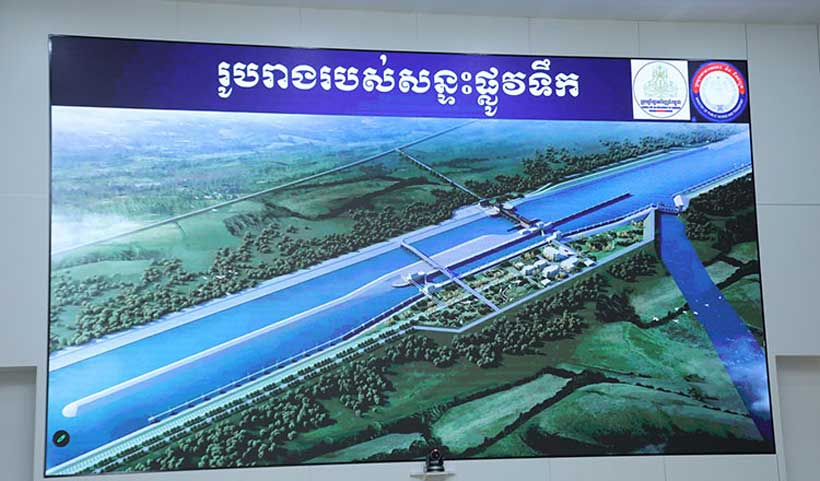Recently, both the US and Vietnam have raised concerns about Cambodia’s Funan Techo Canal project, a water route connecting the Phnom Penh Autonomous Port to its coastal province of Kep. Besides environmental worries, there is apprehension about the canal locks being used to adjust water levels for the benefit of accommodating a “Chinese military presence in Cambodian territory” next to Vietnam’s border.
In response to these concerns, on April 9, President of the Cambodian Senate, Hun Sen, refuted claims that the canal could facilitate the entry of Chinese military vessels into the Mekong River.
“Why would Cambodia bring Chinese troops into its country, which violates the constitution? And why would China bring its troops to Cambodia, which is contrary to the principle of respect for Cambodia’s independence?” he wrote on his Facebook page.
Also, during his official visit to Vietnam’s capital Hanoi last year, newly appointed Cambodian Prime Minister Hun Manet reassured his Vietnamese counterpart Pham Minh Chinh that preliminary studies on the project “would not impact the Mekong River water system”.
Evidently, the Funan Techo Canal project, holistic environmental and economic development endeavor, has undergone rigorous technical, legal, economic, environmental, and social studies spanning over two years. The government’s thorough approach guarantees that the canal will not only enhance the economy but also safeguard the ecological balance of the region, incorporating effective mitigation measures as a crucial component.
The project is in accordance with Article 5 of the 1995 Mekong Agreement, which requires that any projects on the Mekong River tributaries, including the Funan Techo Canal, must be notified to the Joint Committee. Cambodia has met this requirement accordingly, showcasing its dedication to regional collaboration and sustainable growth. Thus, there are legal operational reasons for Cambodia to implement this project.
As a war-torn country, Cambodia puts utmost significance on the peace and security. Thus, Cambodia has made great stride toward bolstering border relations with its neighbors through the pillars of “peace, friendship and development”.
Furthermore, in December 2021, Phnom Penh and Hanoi issued the joint declaration that emphatically reiterated the unwavering commitment of both countries to prevent any hostile forces from exploiting their territories to undermine the security of the other.
During his address at the 78th Session of the United Nations General Assembly last year, incumbent Premier Hun Manet clearly reaffirmed Cambodia’s position that strongly opposes any acts of aggression against sovereign states, interference in their domestic affairs, and the threat or use of force in international relations.
Absolutely, allowing a foreign military base in Cambodia contradicts the Cambodian constitution. As such, the government unwaveringly abides by the constitution without any compromise. Cambodia is committed to maintaining its existing approach of “independent and neutral foreign policy, grounded in the rule of law, equal mutual respect and adherence to the principles of the UN Charter” in order to advance its domestic interests, nurture current friendships, and cultivate more harmonious relationships.
In this sense, Phnom Penh would refrain from taking sides in the US–China geopolitical rivalry, upholding its independent and neutral foreign policy which explicitly states, “friend to all and enemy to none.”
The Funan Techo Canal project extends over 180 kilometers, linking the Mekong River’s Takeo Canal to the coastal province of Kep, passing through four provinces—Kandal, Takeo, Kampot, and Kep. Last year, Cambodia signed agreement with China Bridge and Road Corporation (CRBC) to invest in the project under a Build-Operate-Transfer (BOT) contract model.
The construction of the canal is projected to cost a substantial USD 1.7 billion, a significant investment in Cambodia’s future. With dimensions of 100 meters in width and 5.4 meters in depth, the canal will be capable of accommodating cargo ships weighing up to 3,000 DWT. Yet, it still remains too shallow to host large foreign naval vessels.
The construction of the canal is expected to reduce transport costs substantially, with estimated savings of approximately USD 170 for a 20-foot container and USD 223 for a 40-foot container, equating to a 16% decrease in overall transport costs. This cost efficiency will not only benefit businesses but also for consumers, as lower transport costs can lead to more affordable products.
Undoubtedly, given waterway connectivity fundamentally matters for economic development, it allows access to resources, trade, and transportation. According to government’s research, the economic internal rate of return ranges between 20% and 31%, signaling its high profitability potential and promising economic development. Additionally, the canal will have a far-reaching impact, boosting the growth of industrial zones, fostering production lines, and strengthening supply chains in key sectors, especially the agriculture and aquaculture.
Currently, Cambodia heavily depends on Vietnamese ports for importing raw materials from China and exporting goods to the United States and the West. The Vietnam-Cambodia waterway has been instrumental in transporting around 20 million tons of goods since the two nations signed an inland waterway agreement in 2011.
Therefore, once the canal construction in Cambodia is finished, Cambodia will shift its focus to utilizing its waterways, ultimately reducing its reliance on Vietnamese ports for cargo transportation. This is what Prime Minister Hun Manet has recently described as “breathing through our own nose.” This will undoubtedly result in a significant loss of shipping revenue for Vietnam.
As the Funan Techo Canal project holds immense promise for Cambodia’s economic development, greater self-reliance and connectivity, it will help Cambodia to reach its vision of becoming an upper-middle-income country by 2030 and high-income country by 2050.


